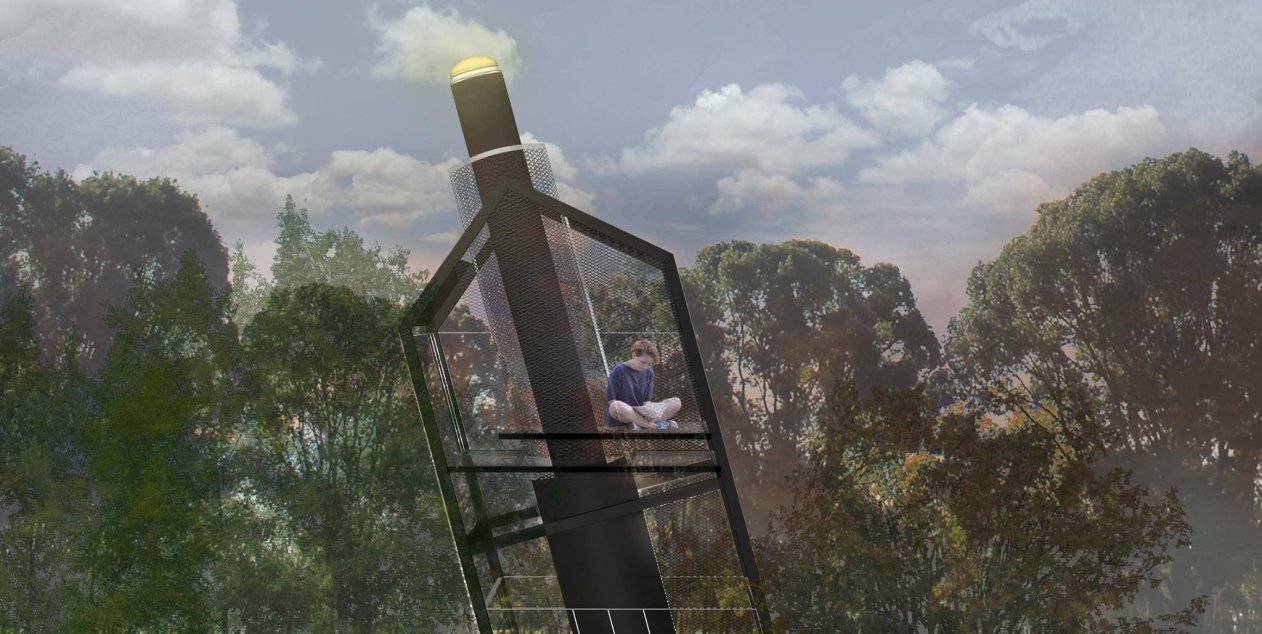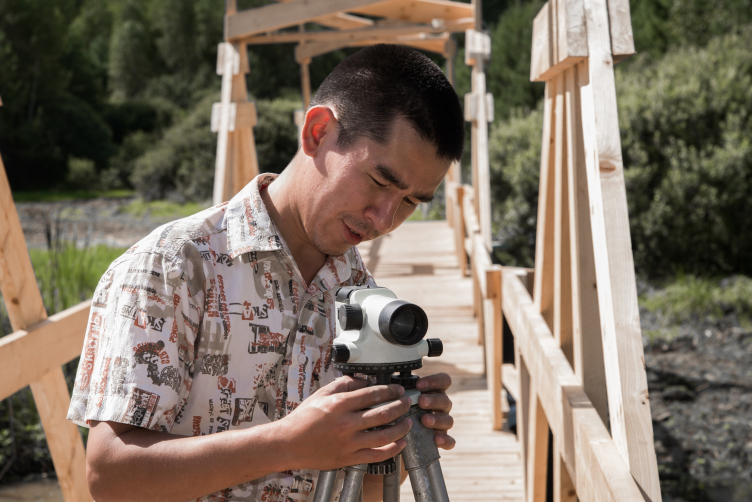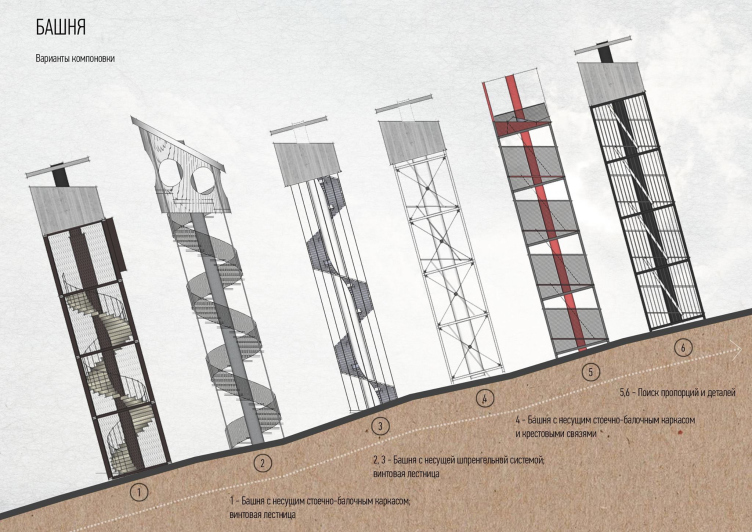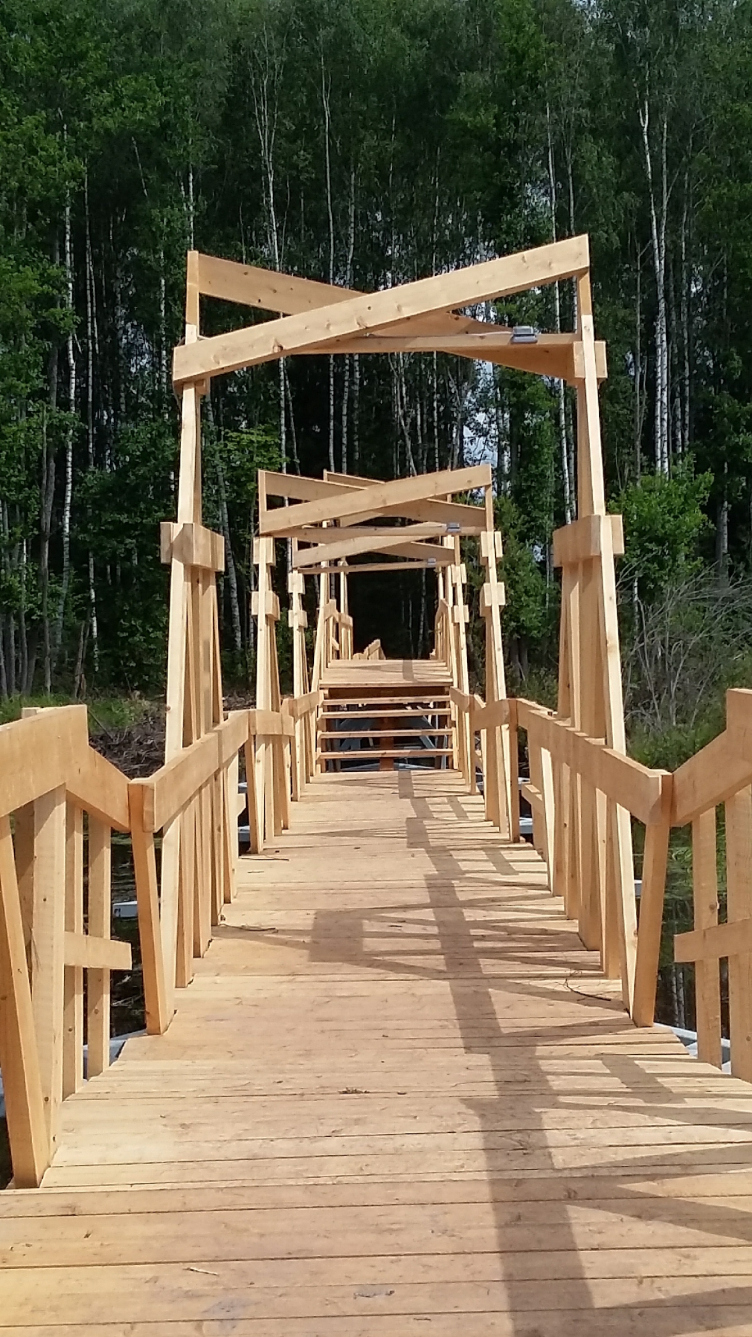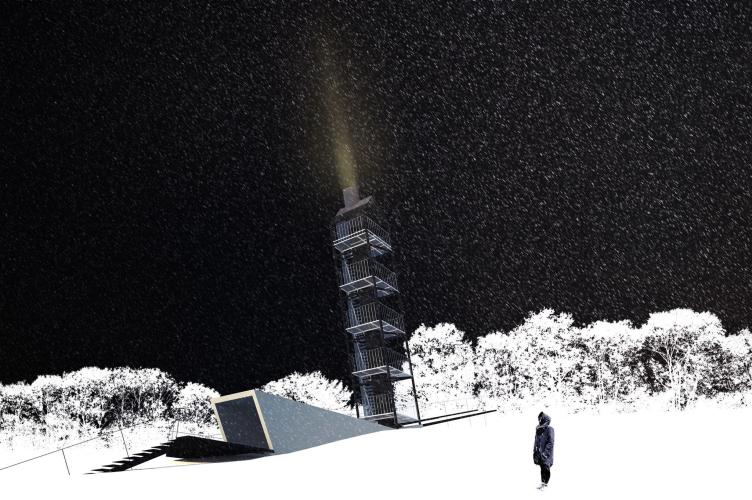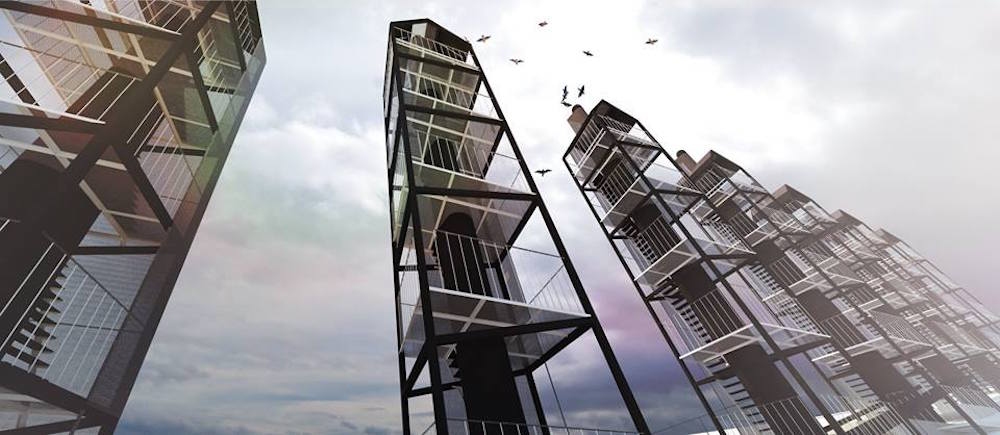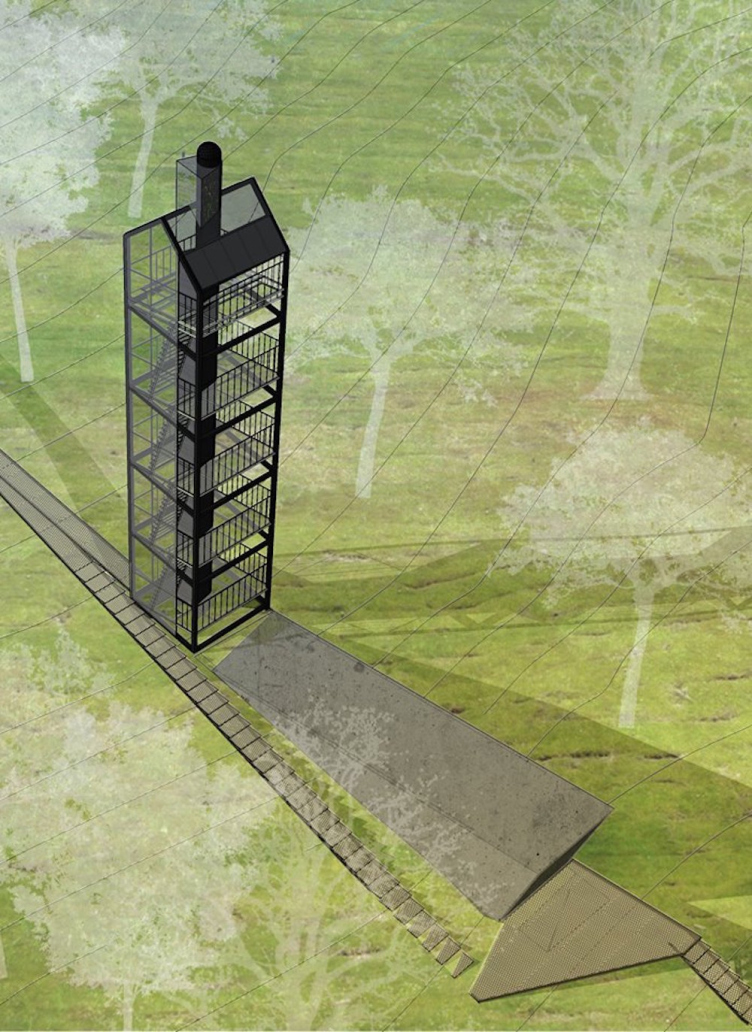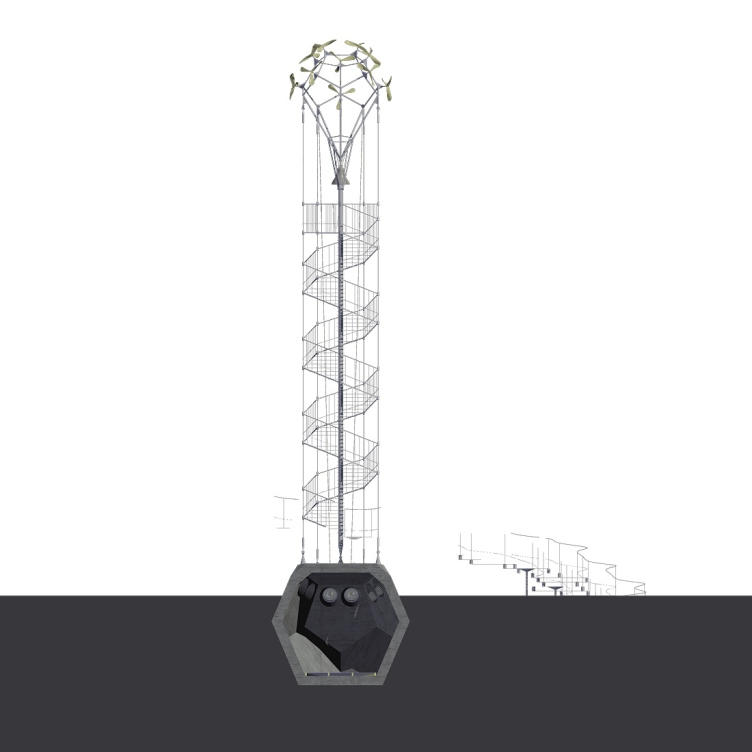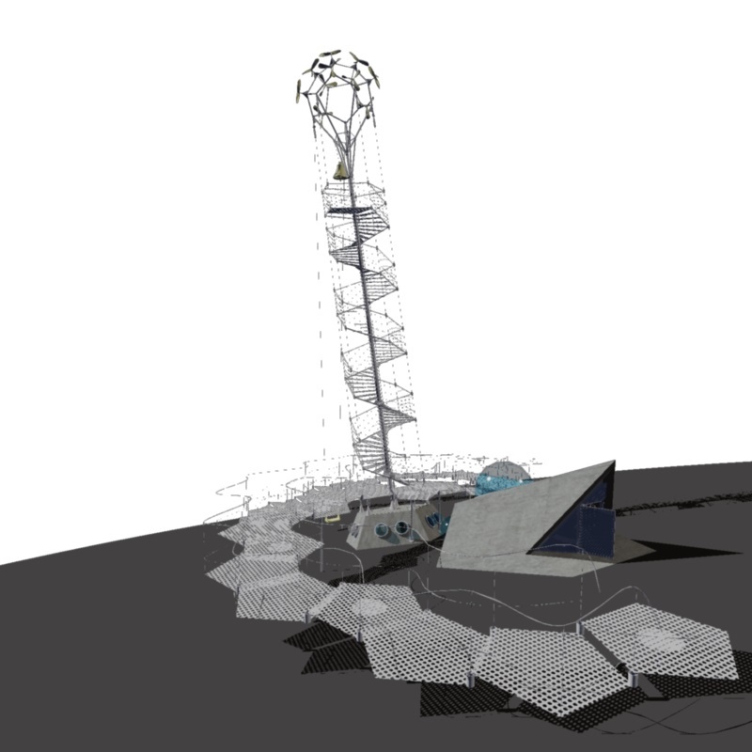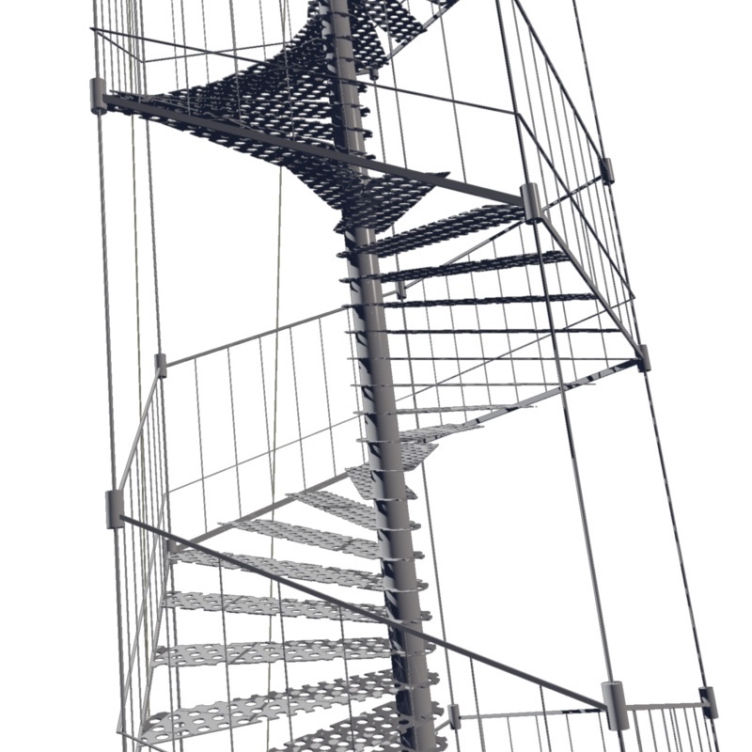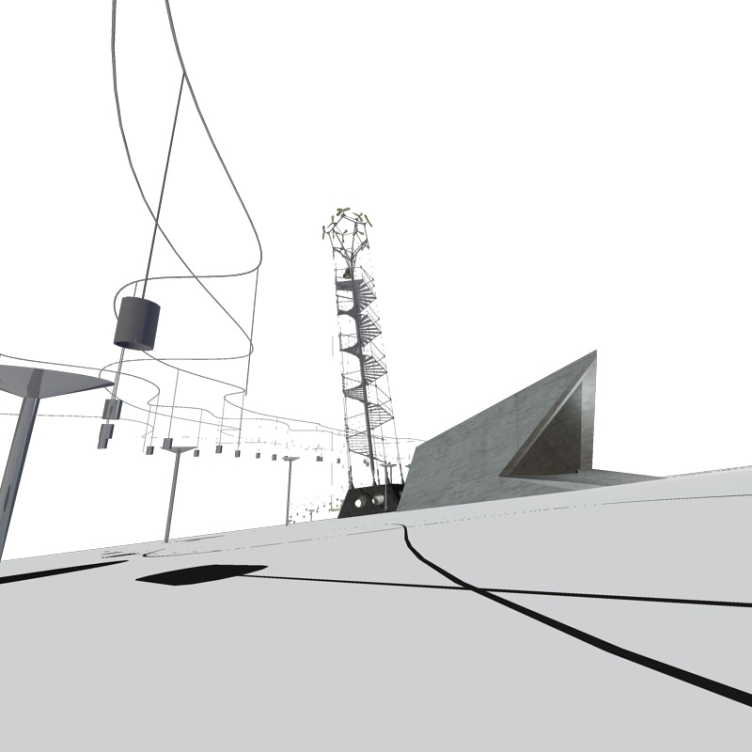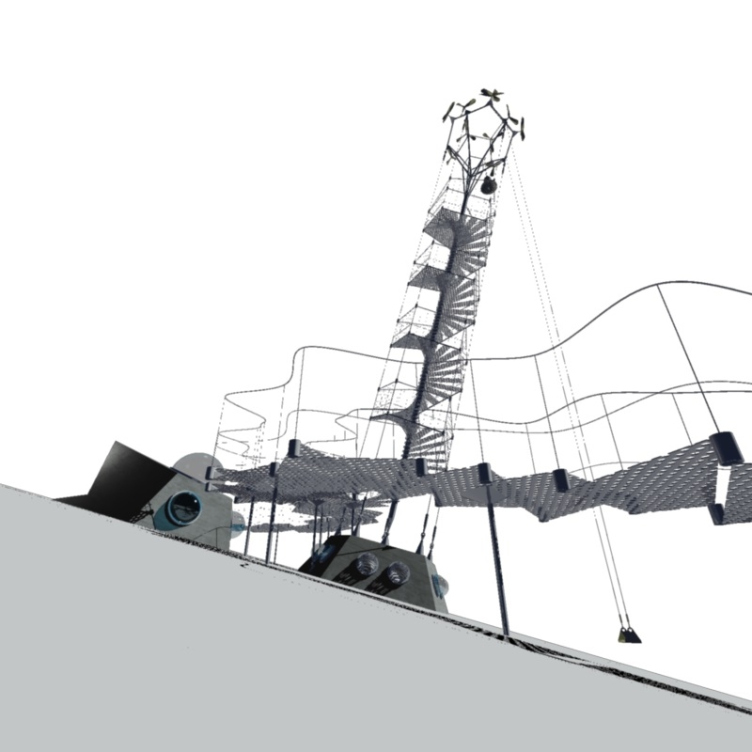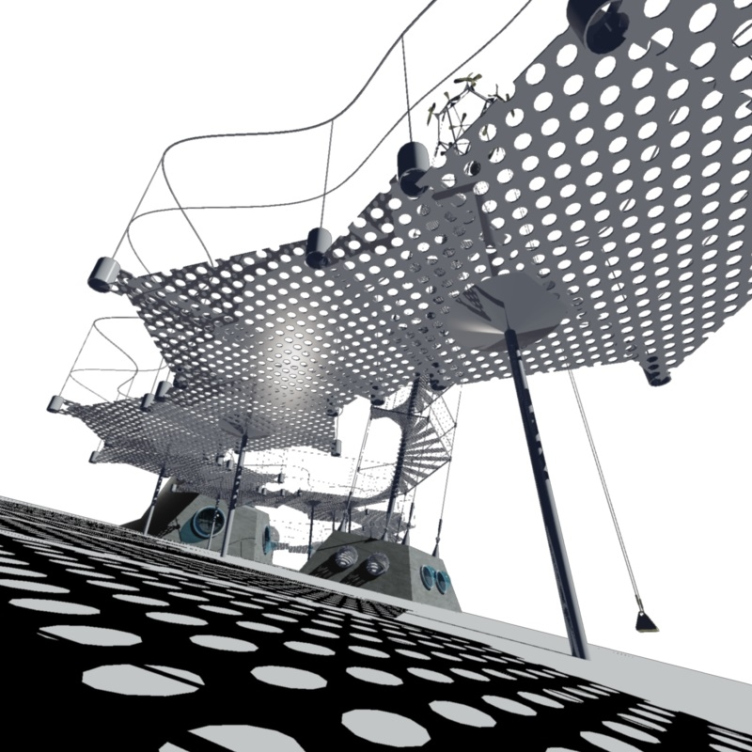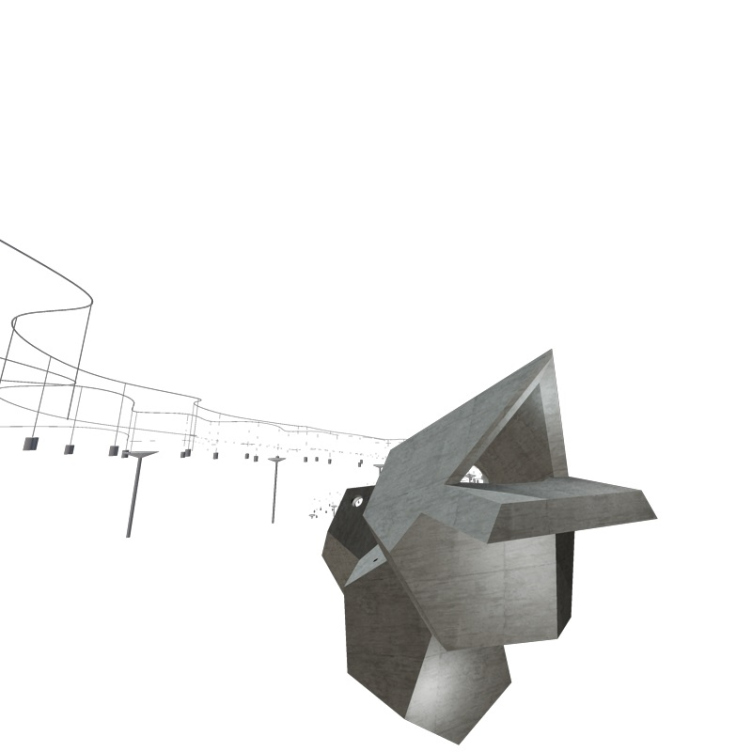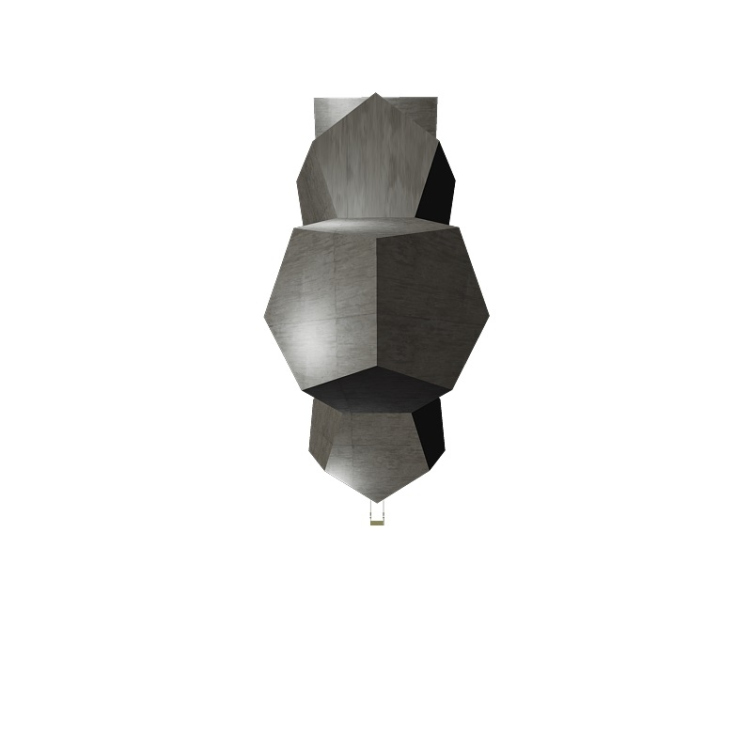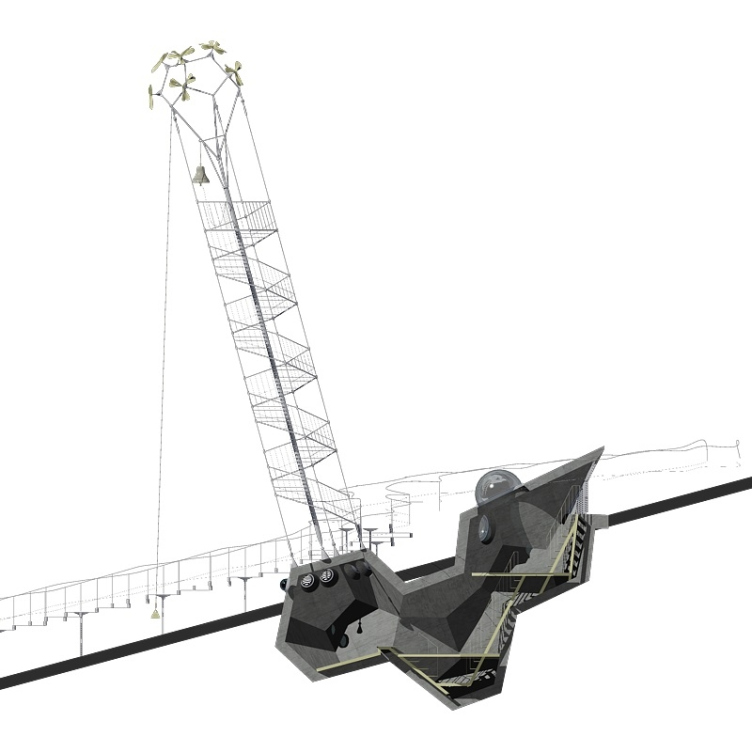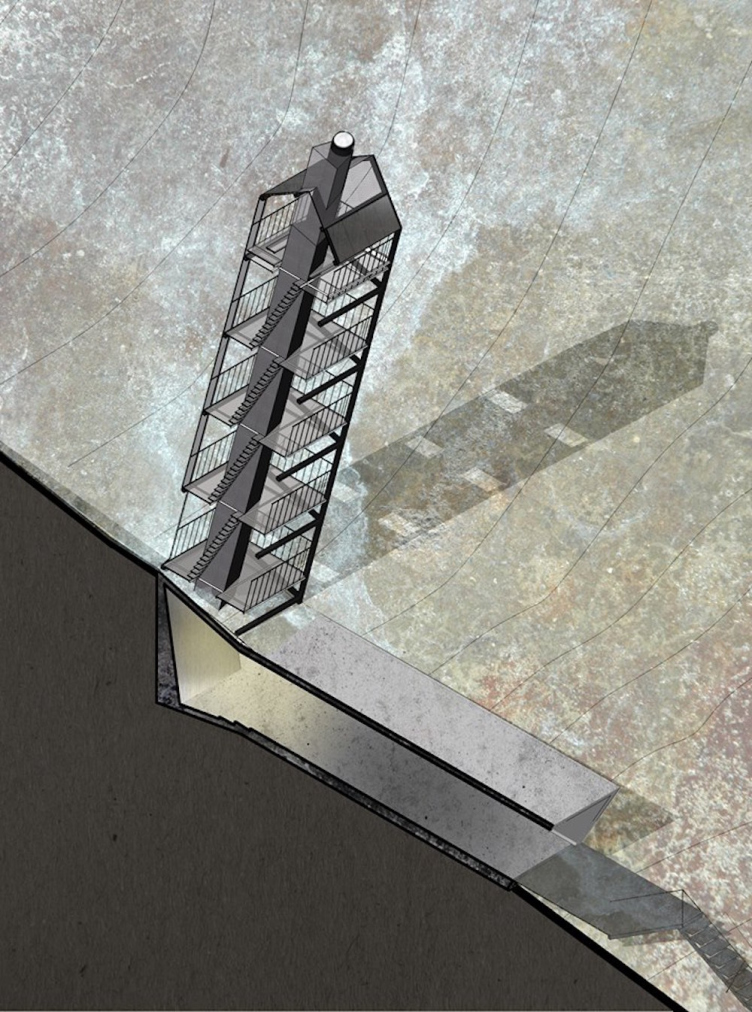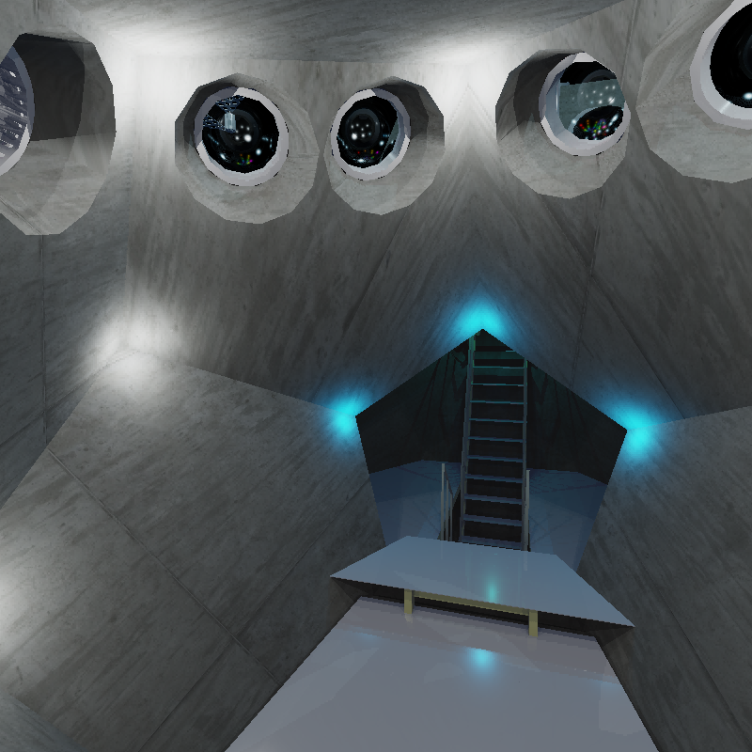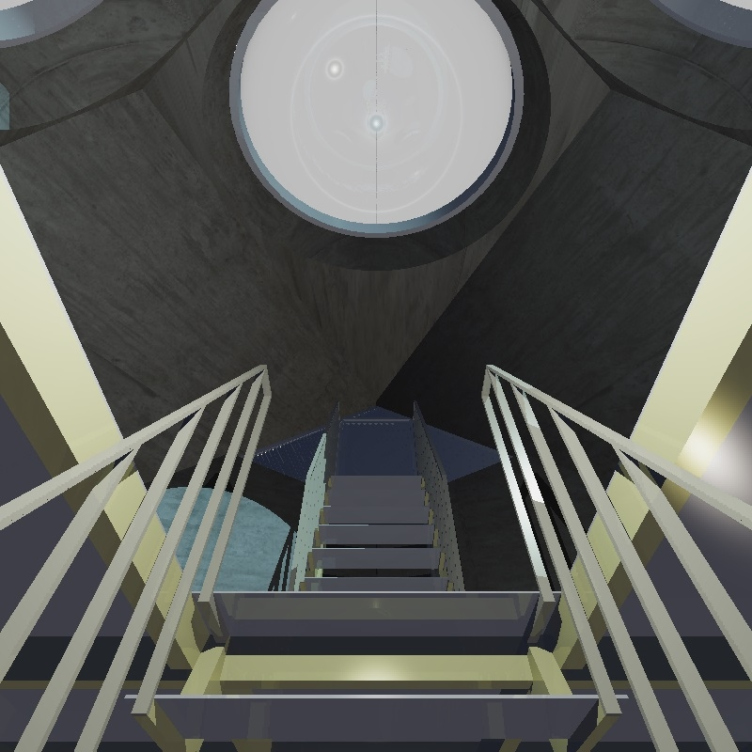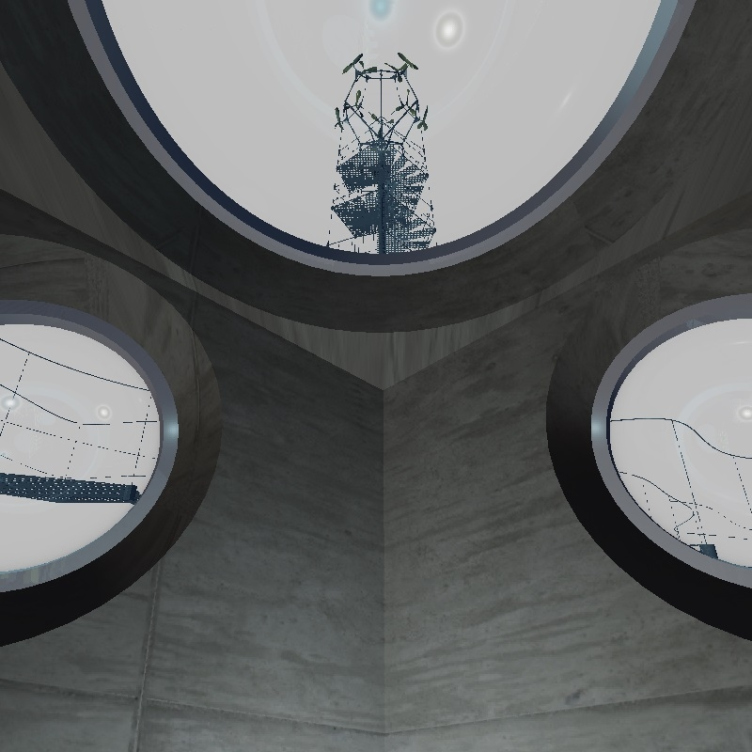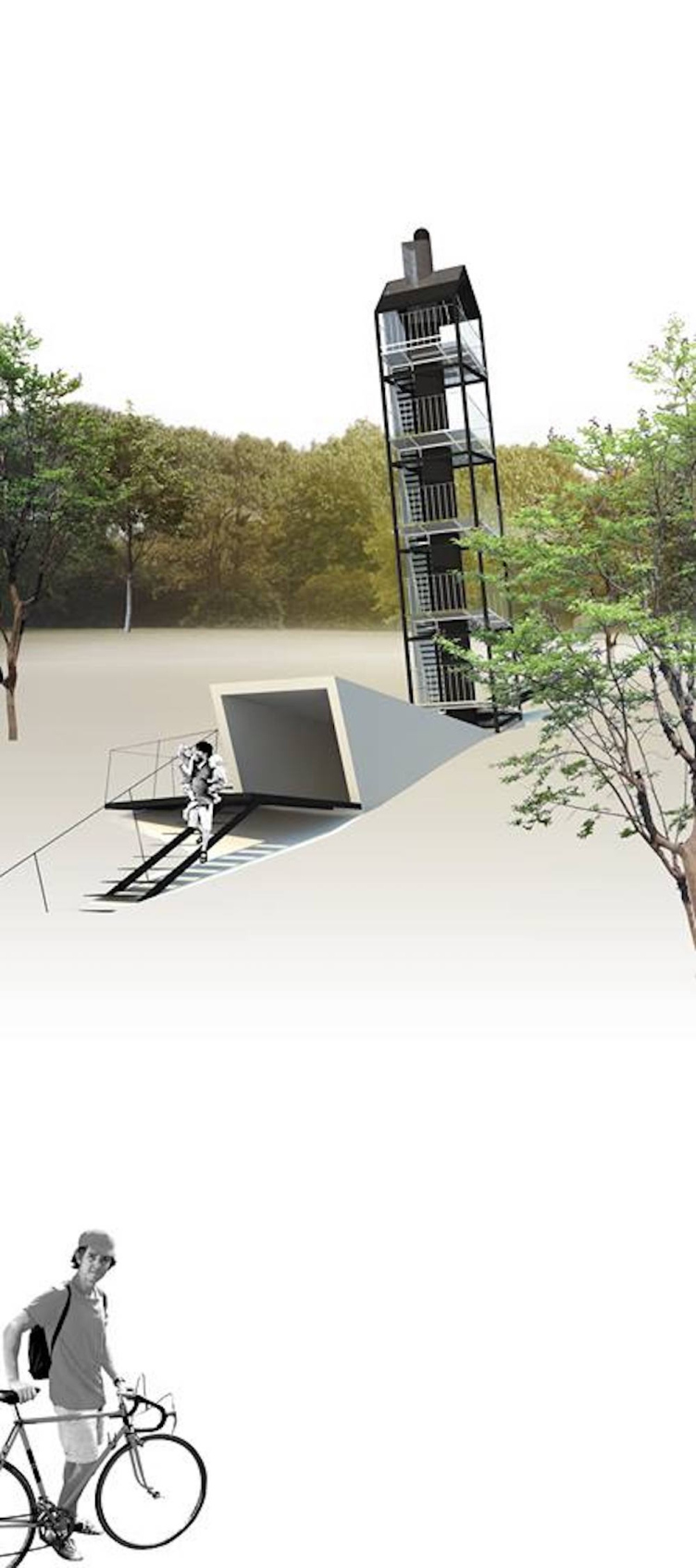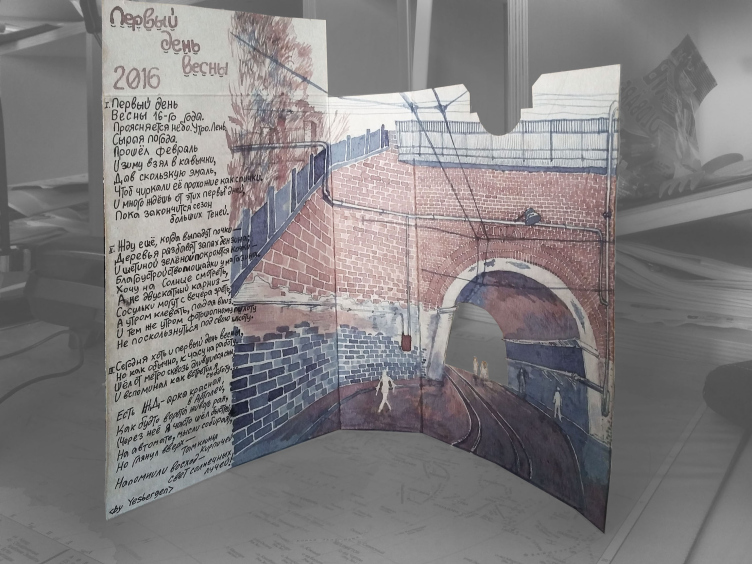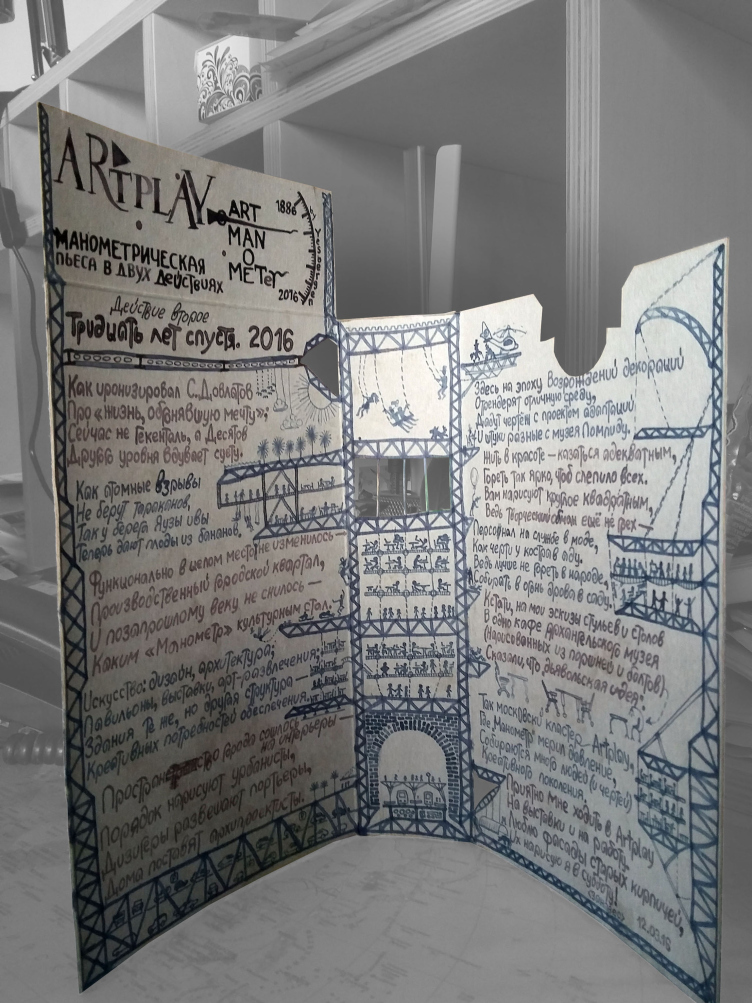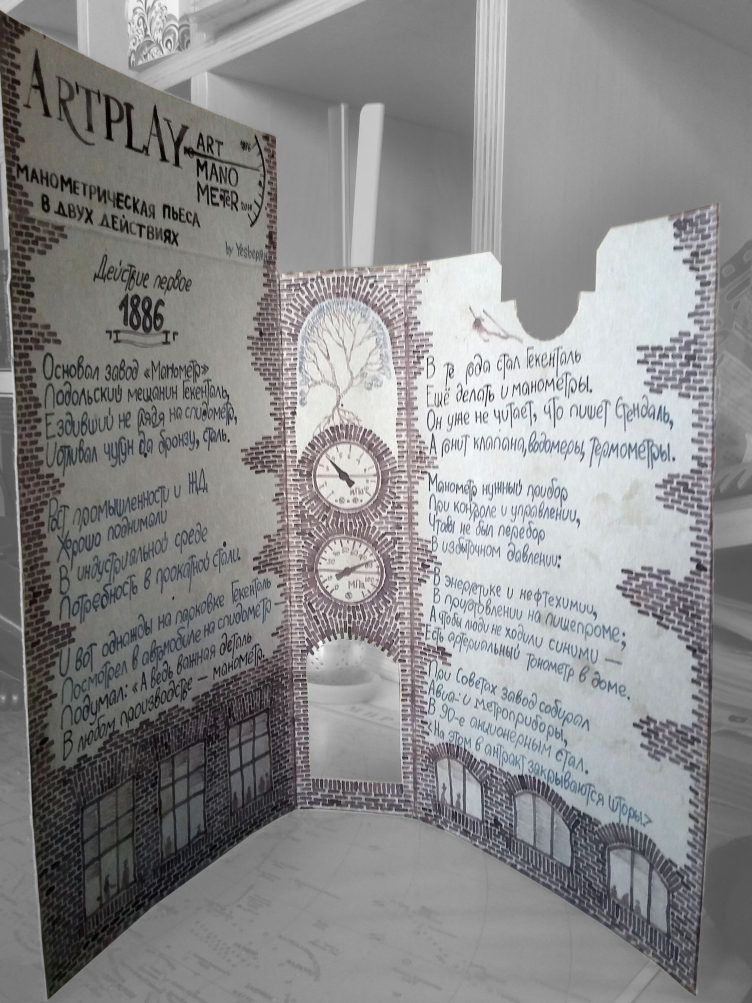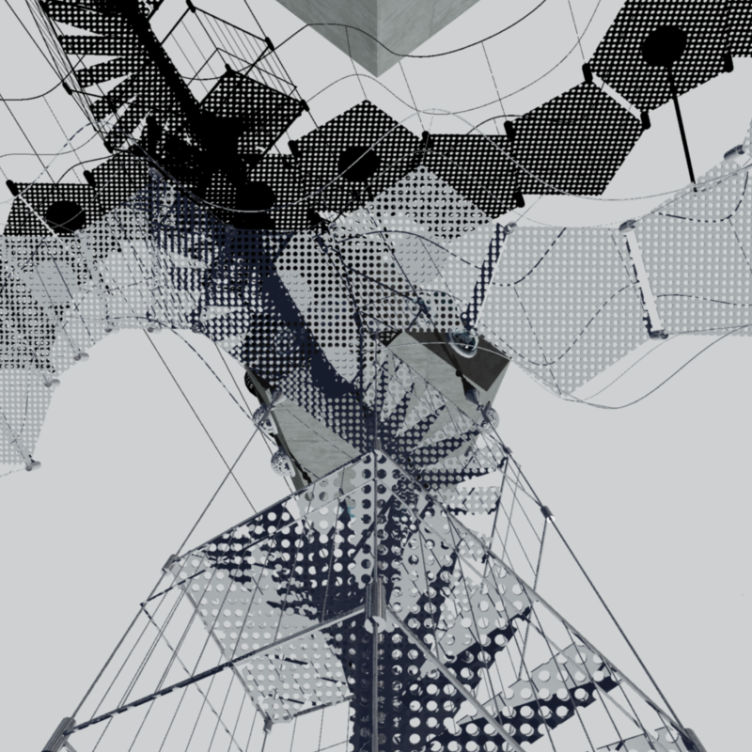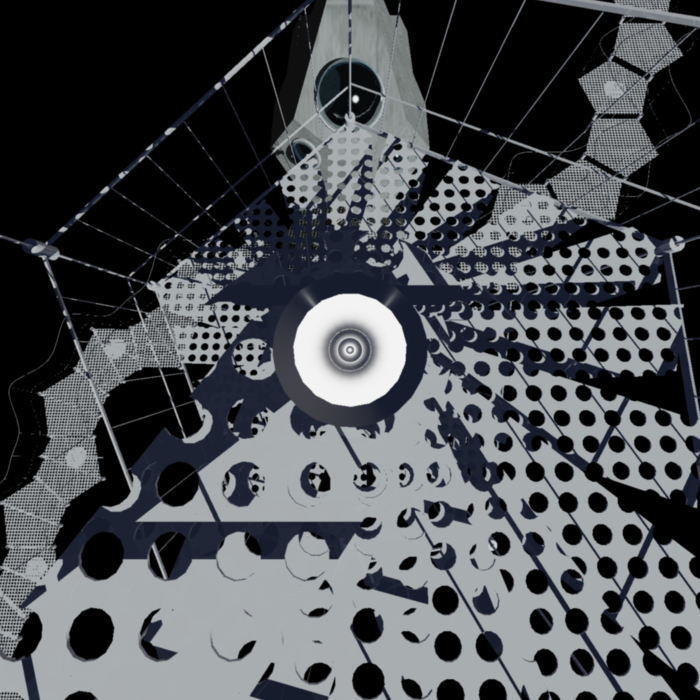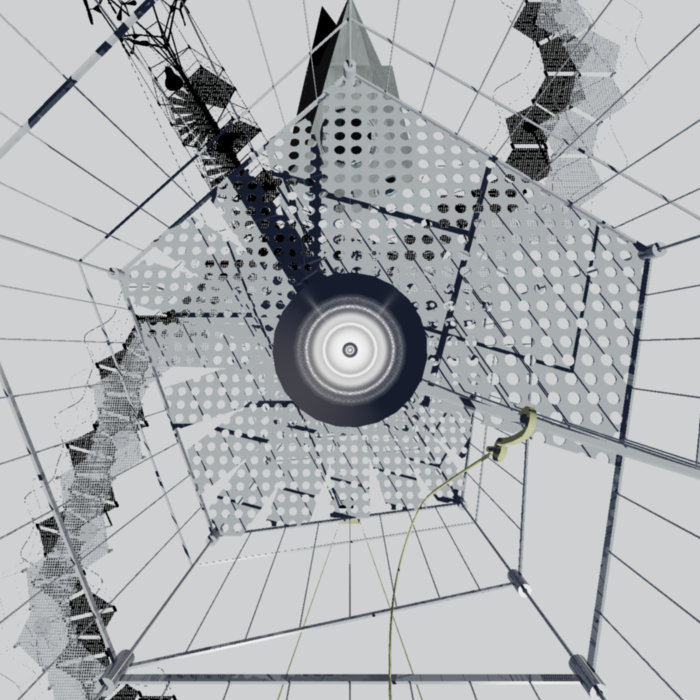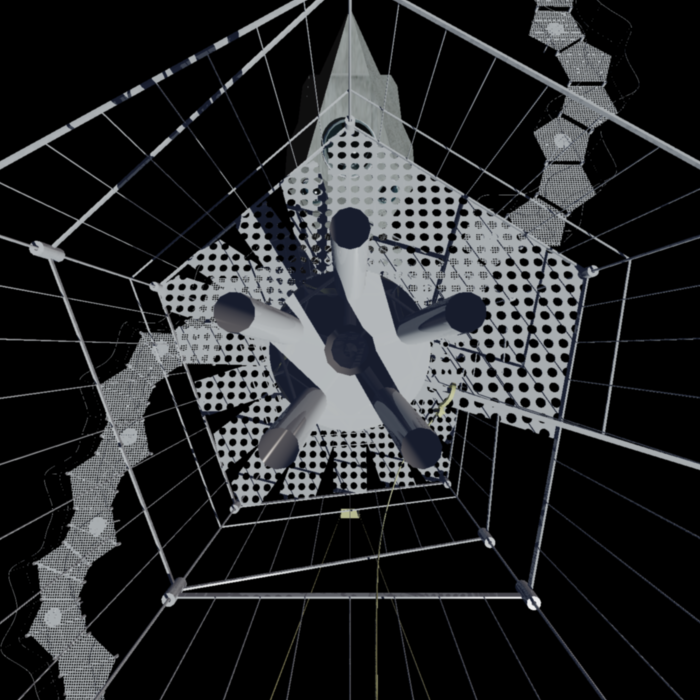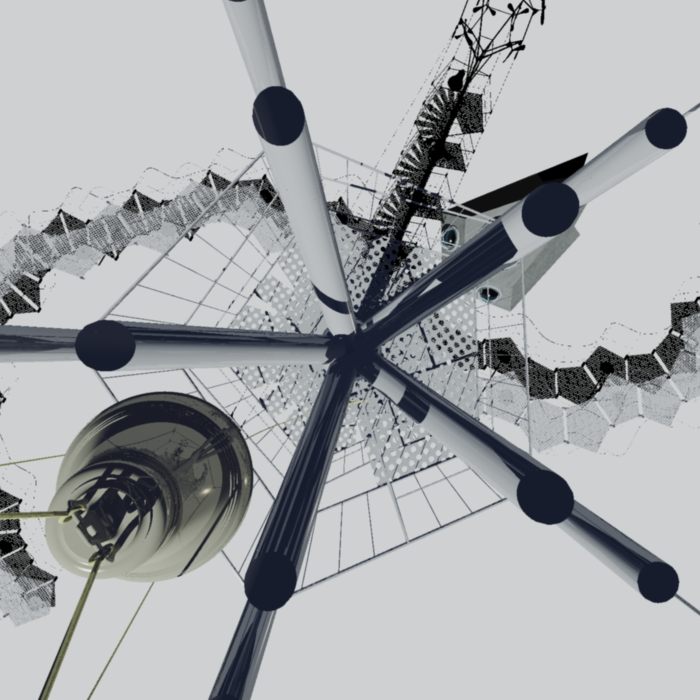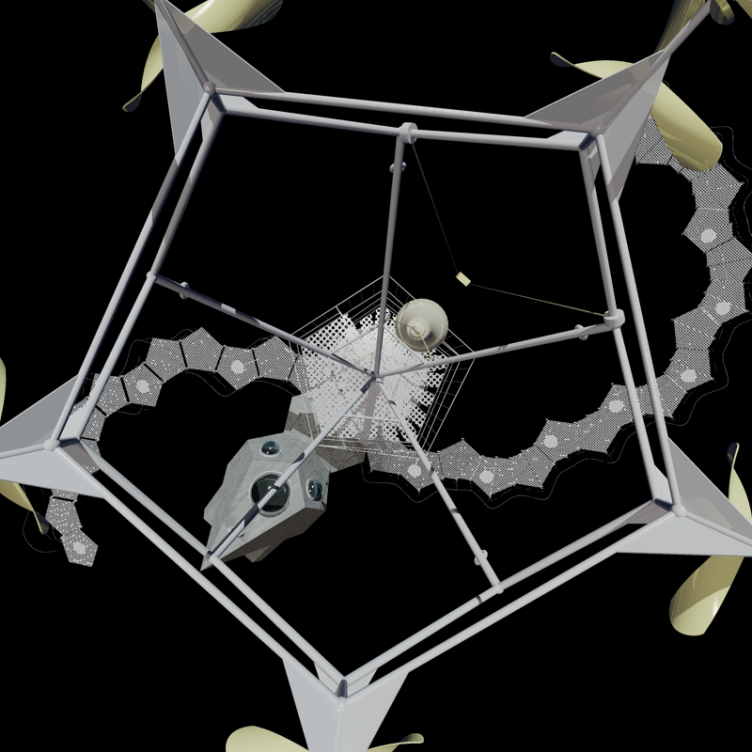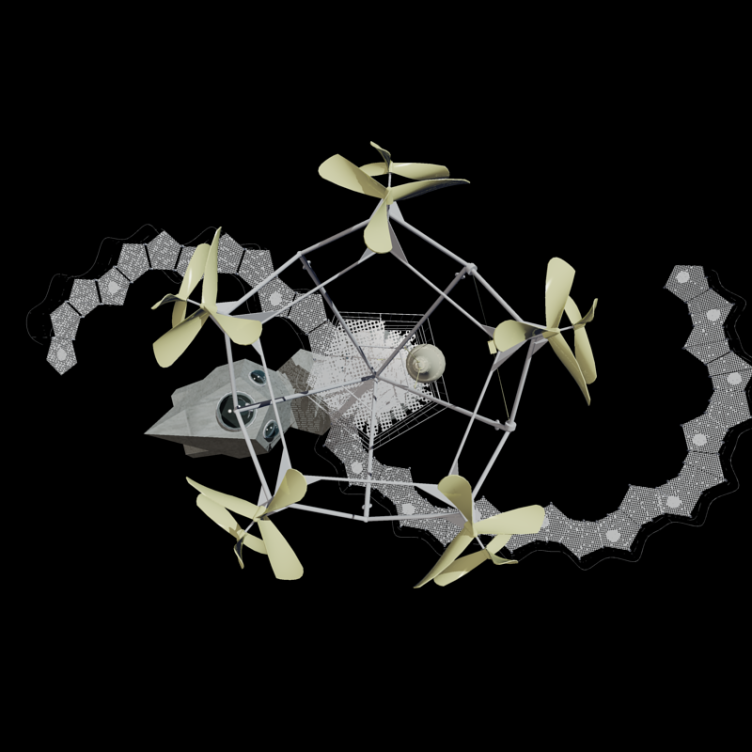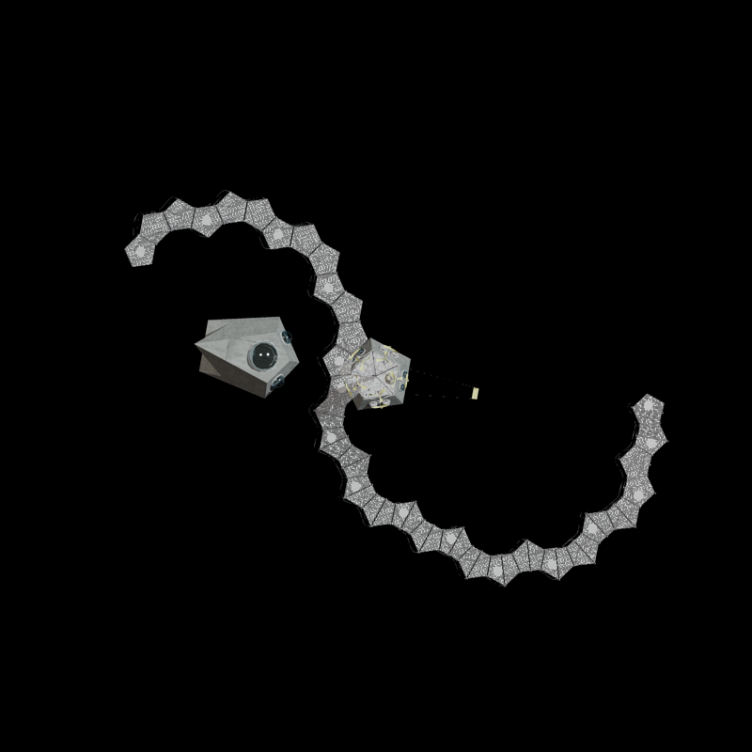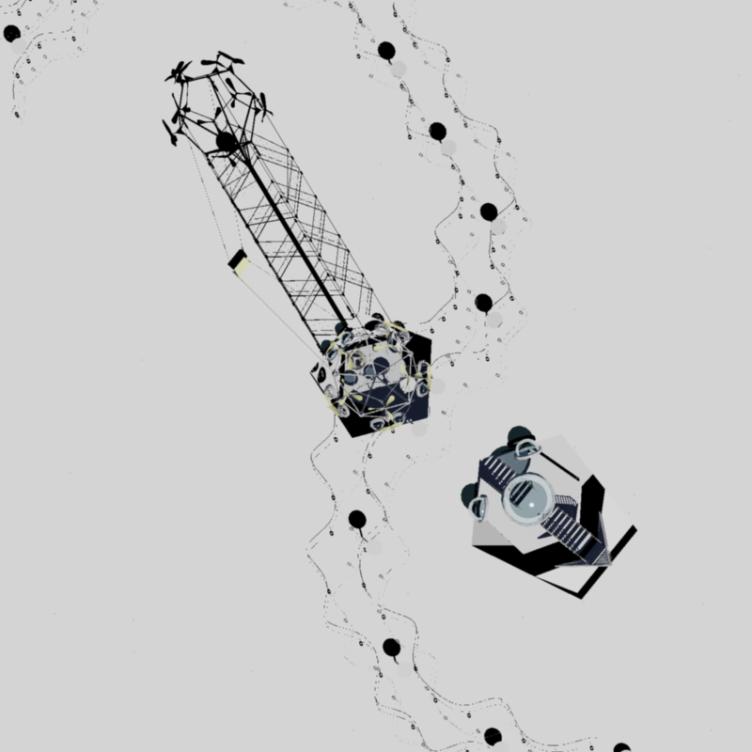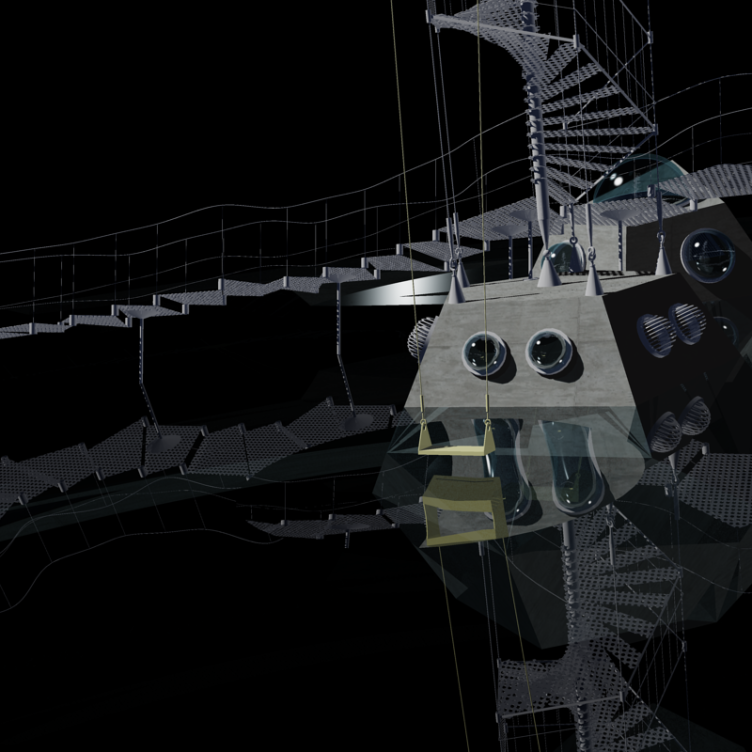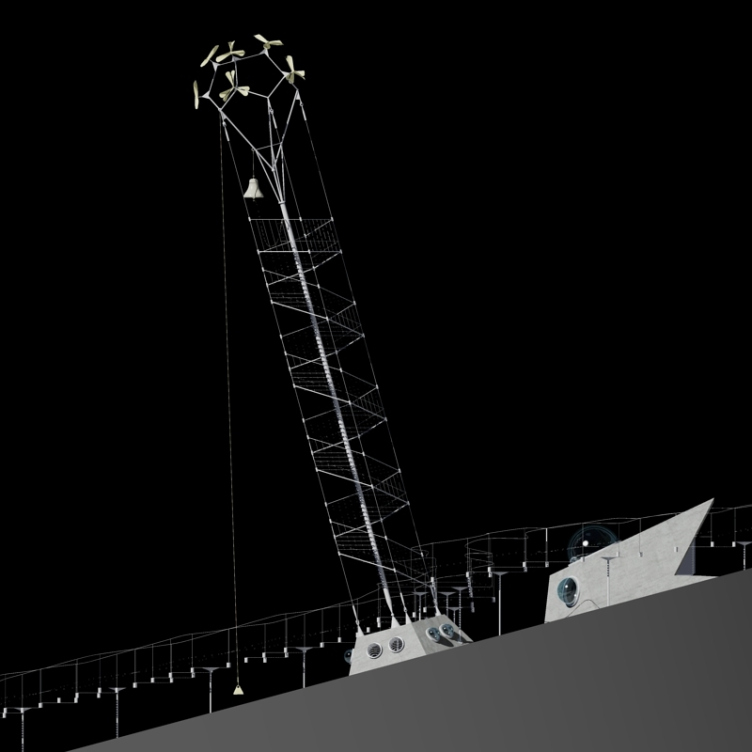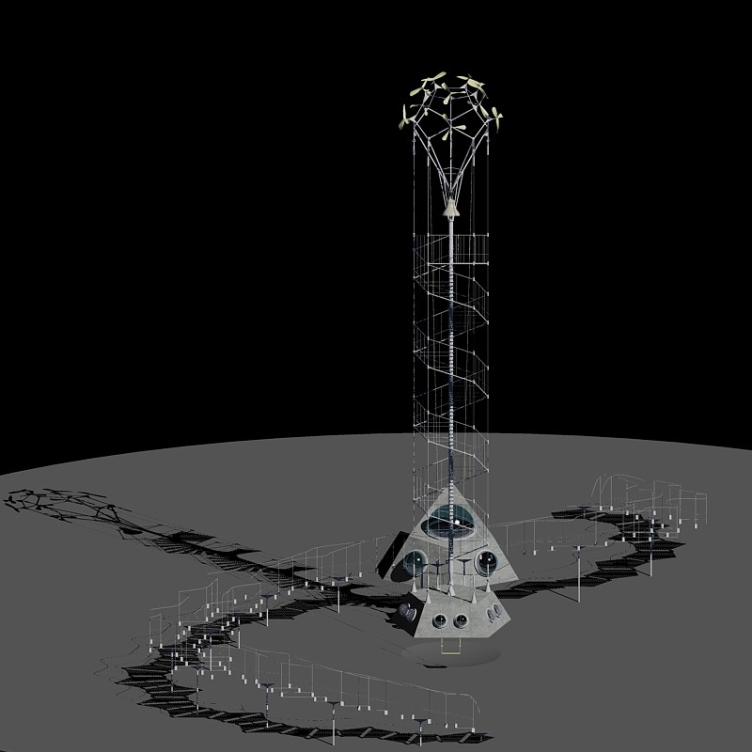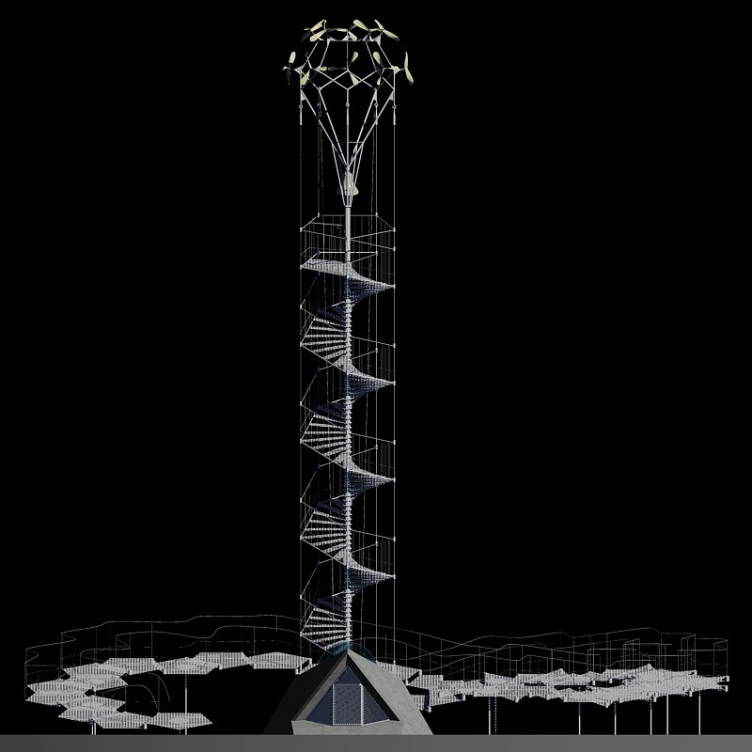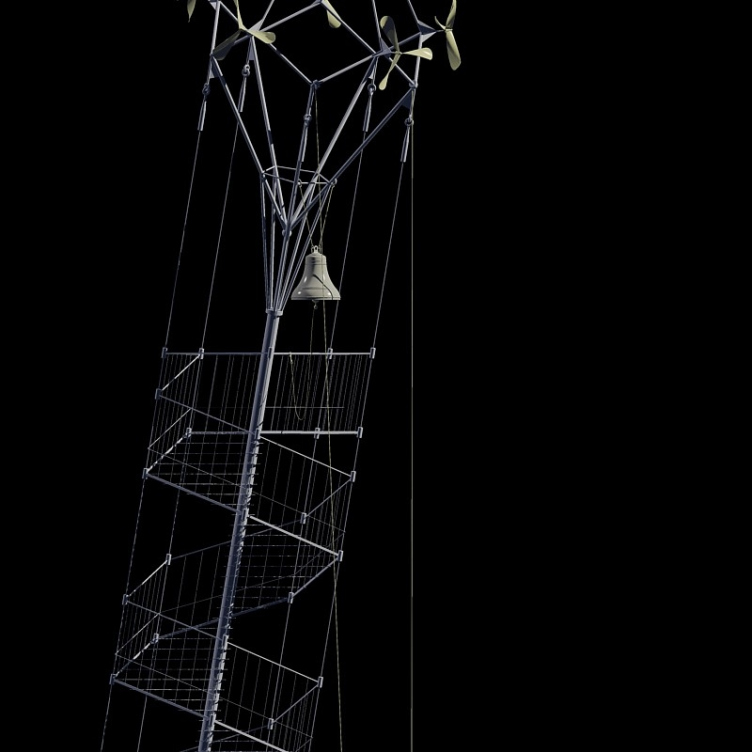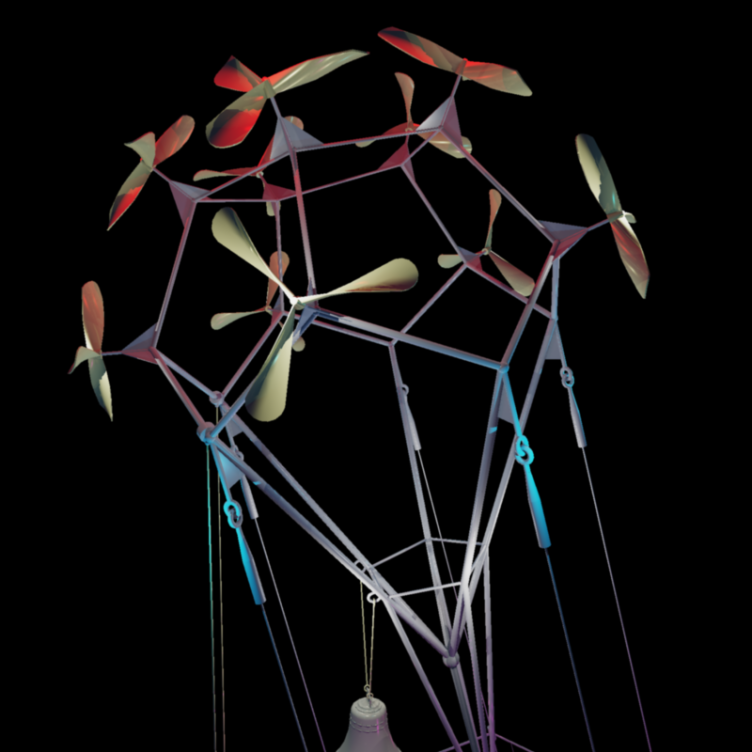Archi.ru
- How did you guys came to the idea of taking part in this "Home for Shakespeare" contest?
Oleg Shapiro:
- This project was initially prepared for "Arkhstoyanie" Festival. This year's theme was "shelter", and they invited us to participate. By joint efforts of the members of our team we came up with a shelter in the form of a tower, and we called our project "Perpendicular". This was our joint project that was developed under my supervision but Esbergen at once came up with a very eccentric version that, regretfully, did not fall in line with the ideas of our team. I also drew a parallel - just like we wanted to place our tower in an inconvenient place (on a slope and perpendicular to it), so Esbergen wanted to "cross" our joint idea.
We could not accept his version for "Arkhstoyanie", but he was able to find another great application for his work - he sent it to "Home for Shakespeare" contest and won it! I saw from the very start that this was a great work, and a great work simply cannot go to waste. Then we refrained from our idea to do a "shelter" in accordance with "Arkhstoyanie" concept of this year, and started designing a bridge in Nikola-Lenivets. Esbergen also poured his soul into that job, and, actually, it is thanks to his efforts that we were ultimately able to build that bridge. He came up with lots of ingenious solutions that helped us implement our project in spite of the fact, as always, we were short of money, time and manpower. But Esbergen and his team were able to handle the first construction stage - which pretty much gives us a reason to believe that soon we are going to see the second stage of the bridge construction.
Esbergen Sabitov at the bridge in Nikola-Lenivets. 2016. Photo © Olga Grib
The project of a tower "Shelter" prepared for the "Arkhstoyanie" Festival. 2016 © Wowhaus
The bridge at the "Arkhstoyanie" Festival 2016. Photo © Olga Grib
- Could you please share more about the tower that you prepared for "Arkhstoyanie"?
Esbergen Sabitov:
- I don't think that my idea of the tower for "Arkhstoyanie" was at odds with the context. A tower is something that provides a connection between heaven and earth. Our tower consists of two parts: an open and a closed one. Down below, underground, I designed the closed part, very much like a bunker. This is a shelter in the direct meaning of the word. Then the tower itself and its upper landing are open; this is rather a metaphorical interpretation of the idea of "shelter" - a solitary place for introverts that gives you an opportunity to achieve your dreams and tear yourself away from the earth.
The project of a tower "Shelter" prepared for the "Arkhstoyanie" Festival. 2016 © Wowhaus
The project of a tower "Shelter" prepared for the "Arkhstoyanie" Festival. 2016 © Wowhaus
At "Arkhstoyanie" we were given a different situation: the tower was to stand near a river, on a hill, on the axis of the bridge direction. Such kind of terrain conditioned our search for the right design solution. This question was considered by all of us, a team of eight people. Ultimately, we opted for the most simple and cost-effective version of a framework construction. My idea, however, was different even from the technical standpoint: together with our designer, we came up with a "string" strutted tower. This same principle is used, for example, in the Ostankino TV tower - the core and the ropes holding it. My tower was even fairly well received but later on they decided that this was a very complex and prohibitively expensive solution, even though I do not agree with this at all. Just as was the case with the bridge - if you have a goal that you are really committed to, you will be sure to find a solution.
The project of a tower "Shelter" prepared for the "Arkhstoyanie" Festival. 2016 © Wowhaus
The project of a tower "Shelter" prepared for the "Arkhstoyanie" Festival. Location plan. 2016 © Wowhaus
But, as Oleg Shapiro said, my project of the tower was laid off. We started doing the bridge. And, while in the process of doing the bridge, I saw at Archi.ru the announcement of "Home for Shakespeare" contest. I learned from the organizers about the details and the technical specifications, and it turned out that this was solely a contest of proposals and concepts, and you could choose virtually any project, ways of presentation, and style of description. This is why I decided to use for that contest my project of the then-forgotten tower that I had initially prepared for "Arkhstoyanie".
- What changes did you make to the project in order to turn it into "Home for Shakespeare"?
Esbergen Sabitov:
- The subject of the contest was not so much about designing a house for a human being to live in it, as about evoking allusions and associations with Shakespeare and his cosmos. This was not about "designing a house", like a project with a bathroom and a kitchen but a world where a certain person exists. This was the way it was put in the contest assignment: tell a story through architecture. This is why I decided that a tower really matches "Shakespeare's cosmos", the connection between the two fields, or, poles, if you want - creativity and society. Since the choice of the situation was mine to make, my "Home for Shakespeare" is situated in its own environment, on the hillside of Nikola-Lenivets, as if on a theater stage. But then again, one should say that such a tower can be built in any situation - which again proves Shakespeare's quote that "all the world’s a stage".
"Home for Shakespeare" contest project. Author: Esbergen Sabitov. A shot from the movie. 2016 © Wowhaus
"Home for Shakespeare" contest project. Author: Esbergen Sabitov. A shot from the movie. 2016 © Wowhaus
The tower is associated with the Globe Theater founded by Shakespeare. In the explanatory note to my project I wrote that tower's inner stairway must have on it all the heroes of Shakespeare plays - they would be not only actors but they would be spectators as well, examining the surroundings and recognizing their roles in it. This is why the difference between "Home for Shakespeare" from the "Arkhstoyanie" tower is rather ideological than technical.
"Home for Shakespeare" contest project. Author: Esbergen Sabitov. A shot from the movie. The stairway. 2016 © Wowhaus
"Home for Shakespeare" contest project. Author: Esbergen Sabitov. A shot from the movie. 2016 © Wowhaus
"Home for Shakespeare" contest project. Author: Esbergen Sabitov. A shot from the movie. 2016 © Wowhaus
"Home for Shakespeare" contest project. Author: Esbergen Sabitov. A shot from the movie. The stairway. 2016 © Wowhaus
The line of the "shelter", an open and a closed space (a tower and a bunker respectively), like I said, is still there in the project. Based on the connection between these two parts, I created a video that became a part of my contest presentation of the project. I made it in full accordance with the rules of plot development, and created a video version of my project - you approach the tower, its view from the hillside becoming the establishing shot; one's ascent uphill stands for the swell of the rhythm, the struggle, and the drama; one's descent into the bunker is a tragedy, and one's return to daylight is the finale, a happy end.
"Home for Shakespeare" contest project. Author: Esbergen Sabitov. A shot from the movie. The bunker. 2016 © Wowhaus
"Home for Shakespeare" contest project. Author: Esbergen Sabitov. A shot from the movie. The bunker. 2016 © Wowhaus
"Home for Shakespeare" contest project. Author: Esbergen Sabitov. A shot from the movie. Section view of the bunker. 2016 © Wowhaus
- Why did you opt for the movie as a means of showcasing your contest project?
Esbergen Sabitov:
- I asked the organizers how I should showcase or present my project, and they said that there were no limits on the ways of presenting it. I had a model ready, and I decided to make an animated video out of it. Simply submitting drawings and visualizations seemed to me a boring thing to do. And as for the movie, it was sort of recreation for me, something that helped me to distract myself from working on the bridge. If you watch the video you will see realism flow into metaphors, get distorted to the point of drama and then get back to reality again. To me, it was an exciting experience - producing a video about my project.
- Why did you think that it was the tower project that matched the subject of the contest best of all?
Esbergen Sabitov:
- I studied Shakespeare's biography and I learned that his family crest indeed displayed a spear. And my tower, standing perpendicular to the hill, also pierces the earth like a spear. This seemed like an interesting parallel to me.
The project of a tower "Shelter" prepared for the "Arkhstoyanie" Festival. Location plan. 2016 © Wowhaus
- Did you specify in any way the functions of the rooms in the bunker?
Esbergen Sabitov:
- No, I didn't. What the bunker does, it simply continues the idea of developing an architectural form based on the laws of theater play. Its levels gradually go deeper underground, the walls are closing in on you, and you feel ever lonelier. Meaning - in a nutshell, you can describe the plot as being part of human society on the ground, elevation above it, and the tragedy of solitude that ultimately makes us draw conclusions.
- And what about the inside rooms of the bunker - are they different in any way? Does each of them become a part of the plot in its own right?
Esbergen Sabitov:
- Yes, the bunker is divided into three rooms. The first one is like an anteroom; it has windows in it - i.e a connection to the outside world - and is situated the closest of all three to the ground level. Then you can get two levels down to find yourself in a dead end. The second room is more like a corridor where you can sit down and make a stop; this is like a transition room. The last space is a closed one, and it is, like I said, a dead end. Together they seem to be like some bio-form - on the one hand, they are independent but, on the other hand, they are continuations of one another.
"Home for Shakespeare" contest project. Author: Esbergen Sabitov. A shot from the movie. The bunker. 2016 © Wowhaus
"Home for Shakespeare" contest project. Author: Esbergen Sabitov. A shot from the movie. The bunker. 2016 © Wowhaus
"Home for Shakespeare" contest project. Author: Esbergen Sabitov. A shot from the movie. The bunker. 2016 © Wowhaus
- If the tower of "Home for Shakespeare" is rather about an idea than about a function, can we say that same about the tower for "Arkhstoyanie"?
Esbergen Sabitov:
- No, the tower that we built for Nikola-Lenivets has quite a specific function. It can become a sightseeing platform because on that side of the territory there are a lot of great views that one cannot see now. On the other side of the river, there is a great place of Nikolino Ukho, and this side of the river, there is virtually nothing to see - which is a pity - because these parts are also very picturesque. The tower can also become an extra link on the axis of our bridge between the Meander Valley and the Polissky Stool. All the more so because the Versailles Field is already highly developed, it's got many projects on it, and Meander is only just beginning to get filled up.
Of course, we will take the seasonal factor into consideration but I think that the idea of a tower is more than relevant to this place, so we will by all means try to implement it.
The project of a tower "Shelter" prepared for the "Arkhstoyanie" Festival. 2016 © Wowhaus
- What will be the further destiny of "Home for Shakespeare". Will they organize an exhibition based on the results of the contest?
Esbergen Sabitov:
- Unfortunately, I don't know anything about it. This contest was by default free and organized on a voluntary basis, without any prizes or registration charges. But I do have plans for further cooperation with the organizers. I don't do this to win any prizes but to get interesting contacts.
My victory in that contest gave me an incentive to move on with my creative activities because, apart from designing, I also write poetry. While the Nikola-Lenivets Bridge was in construction, I realized that I wanted to write about it during different seasons of the year. Also, this autumn I plan to have my personal exhibition at "Artplay" Center. I will showcase there my urbanist landscapes of the territory of Artplay itself and the former factory building that it occupies. They are drawn on unfolded cardboard boxes, on a gray background, and remind sketches of theater props. I also wrote poetry to accompany them. This way, I will again address the subject of theater in architecture, one that has already been explored in the project for "Home for Shakespeare" contest.
An object for the personal exhibition of Esbergen Sabitov at Artplay © Wowhaus
An object for the personal exhibition of Esbergen Sabitov at Artplay © Wowhaus
An object for the personal exhibition of Esbergen Sabitov at Artplay © Wowhaus
- The organizers of "Home for Shakespeare" contest are planning to organize more such contests of ideas that can be associated with the worlds of other writers and poets. Do you plan to take part in them?
Esbergen Sabitov:
– Yes, I even get invitations, for example, to take part in "Home for Marina Tsvetaeva" contest. I think that we can even showcase our bridge in Nikola-Lenivets as an example of connection between the creativity and reality. But we will still have to figure out how to do it better.
"Home for Shakespeare" contest project. Author: Esbergen Sabitov. A shot from the movie. View from the inside. 2016 © Wowhaus
"Home for Shakespeare" contest project. Author: Esbergen Sabitov. A shot from the movie. View from the inside. 2016 © Wowhaus
"Home for Shakespeare" contest project. Author: Esbergen Sabitov. A shot from the movie. View from the inside. 2016 © Wowhaus
"Home for Shakespeare" contest project. Author: Esbergen Sabitov. A shot from the movie. View from the inside. 2016 © Wowhaus
"Home for Shakespeare" contest project. Author: Esbergen Sabitov. A shot from the movie. View from the inside. 2016 © Wowhaus
"Home for Shakespeare" contest project. Author: Esbergen Sabitov. A shot from the movie. View from the inside. Metamorphosis. 2016 © Wowhaus
"Home for Shakespeare" contest project. Author: Esbergen Sabitov. A shot from the movie. View from the inside. Metamorphosis. 2016 © Wowhaus
"Home for Shakespeare" contest project. Author: Esbergen Sabitov. A shot from the movie. View from the inside. Metamorphosis. 2016 © Wowhaus
"Home for Shakespeare" contest project. Author: Esbergen Sabitov. A shot from the movie. 2016 © Wowhaus
"Home for Shakespeare" contest project. Author: Esbergen Sabitov. A shot from the movie. 2016 © Wowhaus
"Home for Shakespeare" contest project. Author: Esbergen Sabitov. A shot from the movie. 2016 © Wowhaus
"Home for Shakespeare" contest project. Author: Esbergen Sabitov. A shot from the movie. 2016 © Wowhaus
"Home for Shakespeare" contest project. Author: Esbergen Sabitov. A shot from the movie. 2016 © Wowhaus
"Home for Shakespeare" contest project. Author: Esbergen Sabitov. A shot from the movie. 2016 © Wowhaus
"Home for Shakespeare" contest project. Author: Esbergen Sabitov. A shot from the movie. Fragment of teh tower. 2016 © Wowhaus
